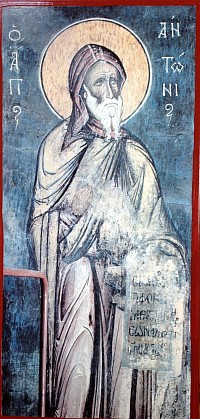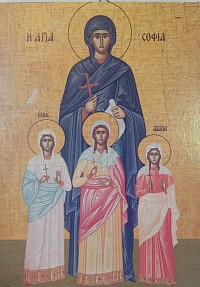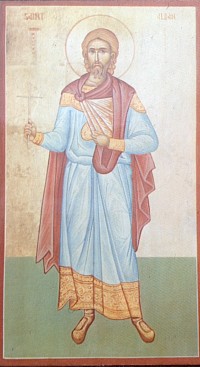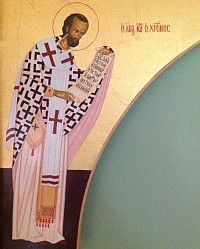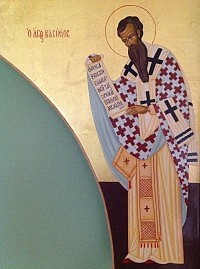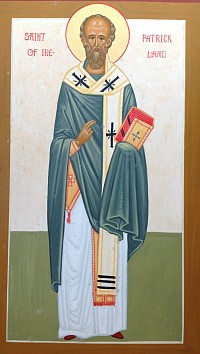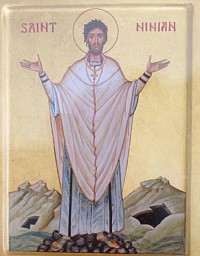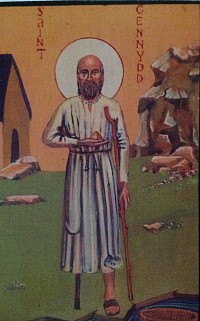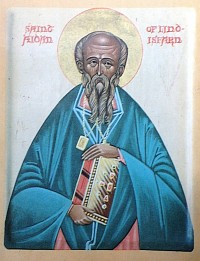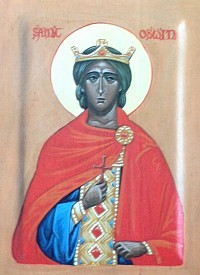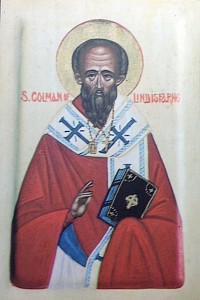Gallery
St Anthony the Great
Born in 251, St Anthony is deemed to be the Father of All Monks, was a prominent Egyptian Desert Father. His biography helped spread the practice of monasticism in the West.
He was born in Coma the son of wealthy landowning parents, who died when he was 18 leaving him to look after his sister. Soon after however, he abandoned this life and placed his sister into the care of nuns, sold and gave away all he had, and went under the tutelage of the harsh ascetic life of monks. He headed out to the Nitrian Desert 59 miles west of Alexandria where he stayed for 13 years. Plagued by the devil his temptations are portrayed throughout the various periods of Christian art. After falling ill and being restored by the villagers who brought him food, he retreated further to a cell set within a more remote mountain near Crocodoplis for a further 20 years.
After failing to become a martyr under persecution, he retreated once again to his cell on the mountain, and over time he attracted hundreds of followers. On the spot of his cell stands the Monastery of St Anthony the Great. His remains are believed to to have been removed to Alexandria in 361 and eventually found their way to St Antoine de Dauphine
St Sophia surrounded by Saints Faith Hope and Charity
Believed to have been born in Italy in the 1st Century, Sophia named her three daughters after the virtues mentioned by Paul (1 Cor. 13:1) Pistis, Elpis, and Agape (Faith, Hope and Love or Charity). In AD 137 when Faith was 12, Hope 10 and Love 9 they were martyred by Hadrian (AD 117 - 138). In an attempt to persuade them to renounce Christianity, Roman soldiers removed the daughters starting from the eldest to the youngest and tortured them individually till they died from the torture. Sophia was then allowed to bury her daughters and remained by their graves till, three days later, she herself died from grief.
It is uncertain whether this is legend or a true account of four people who lived. There are two separate accounts of this telling set in two separate places at two separate times, but it is entirely credible that there were eight people who met death in such a way, so common were their names and so common was Christian death and torture at that time.
St Columba.
The son of a tribal chieftain, Columba was given the name Crimthann when he was baptised shortly after his birth in Gartan, County Donegal. When he was a boy, he was so often found praying in the town church that his friends called him Colm Cille (Dove of the Church) and it was as Colm, or its Latin form Columba, that he was known for the rest of his life.
As a young man, Columba was strongly influenced by one of his teachers, Finian of Clonard, and asked to be ordained a priest. When a prince cousin gave him some land at Derry, he decided to start a monastery. Because of his love of nature, Columba refused to build the church facing east, as was the custom; he wanted to spare the lives of as many oak trees as he could. His foundation of another monastery at Durrow 7 years later was the beginning of an extraordinary decade during which he travelled through Northern Ireland teaching about Christianity and founded some 30 monasteries.
Columba's strong personality and forceful preaching aroused considerable antagonism. He was accused in 563 of starting a war between two Irish tribes and was sentenced by the high king never to see Ireland again, to spend the rest of his life in exile. With 12 companions he sailed from the shores he loved, and settled on the island of Iona off the coast of Scotland. The monks made occasional visits to the Scottish mainland, where they preached the faith. Soon their community had 150 members.
In 575 Columba was persuaded to visit Ireland to mediate in a dispute between the high king and the league of poets. Insisting on remaining faithful to the terms of his exile - that he never see Ireland again - he travelled blindfolded. Although his sympathies were with the poets, his reputation was respected by everyone. He spoke to the assembled nobles and clergy with such force and authority that the king was persuaded to reverse his original decree, and the hostility between the two parties was calmed.
St Alban
According to Bede, Alban began life as a pagan in a settlement called Verulamium. Living at the time of persecution for Christians, he found himself giving shelter to an escaping priest. He was so moved by the example of the priest, that he received baptism. When soldiers arrived seeking to execute the priest, Alban put on the priest's cloak resulting in him being beheaded when he refused under torture to deny his faith. While being led to execution, various watery miracles were alleged to have taken place. We are not told how and why the original executioner chose Christianity at this point, but we are told that the man who replaced him became blind. While some of this story may well be legendary rather than historically accurate, he is recognised as the first British Martyr. The exact year of his death is unknown.
St John Chrysostom
John was born in AD349 in Antioch to Greco-Syrian parents. His father, a high ranking military man, died soon after his birth and he was raised by his mother, Anthusa. Between the ages of 19 and 24 he was baptised and then tonsured as Reader. John's education began with Libanius who taught him rhetoric and Greek language and literature. He then went on to study theology under Diodore of Tarsus. When he was just 26 he became a hermit and took the life of an aescetic committing to memory the bible and choosing the harshest of physical mental and spiritual disciplines. Subsequently, he permanently damaged his stomach and kidneys forcing his return to Antioch.
When he was 32 he was ordained Deacon and five years later was Priested. Over the next 12 years he he grew in popularity, partly because of his preaching in the Cathedral and his writing. He emphasised charitable giving, spoke out against corruption and abuse, especially by the wealthy, established a number of hospitals in Constantinople and urged support for the needs of the poor. His sermons were direct and simple so the less educated could follow him. He wrote, "Do you wish to honour the body of Christ? Do not ignore him when he is naked. Do not pay him homage in the temple clad in silk, only then to neglect him outside where he is cold and ill-clad. He who said: "This is my body" is the same who said: "You saw me hungry and you gave me no food", and "Whatever you did to the least of my brothers you did also to me"... What good is it if the Eucharistic table is overloaded with golden chalices when your brother is dying of hunger? Start by satisfying his hunger and then with what is left you may adorn the altar as well".
When he was 48 he was made Archbishop of Constantinople. When he was told of his appointment he chose to leave Antioch in secret for fear that his departure would cause civil disorder. As Archbishop he wasn't popular with the wealthy and the clergy because he refused to host lavish social occasions when there was so much poverty. He started a programme of clergy reform which included ordering visiting preachers to return to their parishes whom they were meant to be serving without paying them while they were in the city. The Patriarch of Alexandria, Theophilus, sought to bring Constantinople under his jurisdiction and had opposed John's appointment accusing him of being a tad too keen to Origen's influence. John also made an enemy of Aelia Eudoxia, who was the wife of the Emporor Arcadius, who didn't take too kindly to the way John denounced extravagance, not least in the way women dressed.
When he was 54 his enemies held a meeting, the Synod of The Oak, to bring John down resulting in him being deposed and banished, but such was his popularity this was overturned almost immediately by Arcadius. John didn't wait long to have his revenge and denounced dedication ceremonies to a silver statue of Eudoxia near his cathedral. This time he was banished to the Armenian Caucasus where he sought help from Pope Innocent I, Verius Bishop of Milan, and Chromatius Bishop of Aquileia. Pope Innocent lent his support and protested at John's banishment sending a delegation to Constantinople but they never arrived. He was further exiled when he was 58 to Pityus in modern Georgia, but he too never arrived dying on the way at Cormanus in Pontus 14th September AD 407.
John's influence on the church is (not was) immense. He harmonised the liturgical life of the church, and it is said that he laid down one of the two chief liturgies used by the church (the other being that of St Basil) and his Paschal sermon is used every year.
In our community, the ikons of St John Chrysostom and St Basil are placed at the entrance to the Royal Doors marking the fact that they both are said to have authored two of the most important liturgies used by the Orthodox church.
St Basil of Caesarea
St Basil of Caesarea and St John Chrysostom are often pictured as a pair because together they are known in Orthodoxy as the authors of two of the most important liturgies used in Orthodox churches. He was born AD 329 or 330 into a wealthy devout Christian family who lived in what is now Turkey. Shortly after he was born the family moved into his grandmothers house, where he was taught by both his father and grandmother. His father died when he was a teenager around AD 350 and Basil moved back to Caesarea to complete his formal education. It was at this time that he became close to Gregory and the pair were lifetime friends and together the two moved to Athens to receive further education.
Basil left Athens in AD 356 to travel to Egypt and Syria before returning home to take up a teaching post. Then he met a charismatic bishop Eustathius of Sebaste (Armenia) who brought Basil to a Christian faith. Basil decided that he wanted to devote his life to God, and after some years travelling further and learning theology, in AD 358 he started a monastery and in time he began writing. Gregory joined him and they wrote together for a while before Gregory returned to his roots. It was these works that formed the foundation of Orthodox monastic life. By AD 362 he was made deacon to be made priest two years later. Gregory and Basil came together again to fight heresy at a crucial point in the theological development of the church. He became known as a rigid and fierce adherent of orthodox theology, opposing heresy and deviations from the strict Christian line at every level and every opportunity. On June 14th AD 371 Basil was made bishop. As bishop he continued to fight heresy on the wider level and did much to help the poor at the local level. He died of liver disease January 1st AD 379.
St Patrick
Saint Patrick was a Romano-British, Christian missionary who is generally recognized as the patron saint of Ireland. Two authentic letters from him survive, from which come the only generally accepted details of his life.
In 387 he was born at Kilpatrick near Dumbarton in Scotland to Calphurnius and Conchessa. Calphurnius belonged to a high ranking Roman family. Conchessa was related to St Martin of Tours. When he was about 16, he was captured from his home by Irish raiders and taken as a slave to what is now Ballymena in Ireland, where he lived for six years looking after sheep and learning Gaelic before escaping and returning to his family. After becoming a cleric, he returned to Ireland as an ordained bishop in the north and west of the island, but little is known about the places where he worked. By the seventh century, he had come to be revered as the patron saint of Ireland. His life would appear to be well documented, but it is difficult to tease apart what actually happened from what later writers have added as romantic gloss. Much of what is said to have happened is patent fiction to add weight to the figure of Patrick, in the same way that much of what is reported to happen to modern celebrities as reported by the media is fiction. Plus ca change?
The dates of Patrick's life cannot be fixed with certainty but it is generally accepted that he was active as a missionary in Ireland during the second half of the fifth century. He died at Saul, Downpatrick in Ireland between 460 and 490. St Patrick's Day is observed on March 17, the date of his death.
St Ninian
Little is known about his early life except it is safe to assume he was English in origin and at some point was ordained, went to Rome and was ordained Bishop and his episcopal see was established at Whithorn and named after another Bishop, St Martin. The first we hear of Ninian is from the writer Bede who reports that the southern Picts came across him and took kindly to is preaching.
Ninian also founded a monastery at Whithorn which, in time, became famous as a monastic school within a century of his death. Though his success with the Picts was noted, by the time Patrick turned up this success had withered on the vine and died, for Patrick describes the Picts as "apostates", and further evidence that they abandoned Christianity is provided by Columba and Kentigern. There are no substantial contemporary accounts of Ninian, but Bede was pretty rigorous so it's likely that he lived and isn't a fabled character, but other attributions of Ninian were written long after his death and are therefore unreliable.
We are not told how he died, we can reasonably assume from natural causes, but he died about AD 432. His body was interred at Whithorn.
St Cenydd,
Not to be confused with the saint of the same name who was Irish and popular in Scotland, Cenydd was a Christian hermit of the Gower Peninsula in Wales where place-name evidence indicates he was the founder of the church of Llangennyth. Stories about his origins are probably only legendary, recalling as they do the story of Moses in the basket. However, there are some elements of his story that are probably more reliable historically. It is fairly certain he was a cripple and a hermit. (It is said that after being cured by St David in 545, he returned to life as a hermit and prayed for his healing to be revoked.)
Cenydd's Feast Day is marked on 5 July. Up to the early twentieth century the festival was traditionally marked by the displaying of an effigy of a bird from a pole on the church tower, symbolising the legendary birds who cared for the infant Kenny, and the consumption of whitepot or 'milked meat' a dish made of flour, milk, sugar and dried fruits, not unlike a rice pudding or bread and butter pudding. It is thought he died on 27th June.
St Aidan of Lindisfarne
An Irishman, possibly born in Connacht, Aidan was a monk at the monastery on the Island of Iona in Scotland.
The Roman Empire had spread Christianity into Britain, but due to the Anglo-Saxon invasion of Britain, Anglo-Saxon paganism was, by the late fifth century, the dominant religion except in Wales and certain parts of Western England. The foundation of the monastery of Iona, in A.D.563, marked the beginning of an Irish mission in what is now Scotland, while in the south-east, the work of St.Augustine of Canterbury, beginning in 597, represented a missionary endeavour inaugurated in Rome by St.Gregory of the Dialogues (in the West usually known as St.Gregory the Great).
King Oswald of Northumbria requested missionaries from Iona, the pre-eminent monastery of the Irish in what is now Scotland, rather than the Roman-backed mission in the south. At first the monastery sent a new bishop named Cormán, but he met with no success and soon returned to Iona, reporting that the Northumbrians were too stubborn to be converted. Aidan criticised Cormán's methods and was sent as a replacement in 635.
Aidan chose Lindisfarne, an island like Iona and close to the royal fortress of Bamburgh, as his base. An inspired missionary, Aidan would walk from one village to another, politely conversing with the people he saw and slowly interesting them in Christianity. According to legend, the king gave Aidan a horse so that he would not have to walk, but Aidan gave the horse to a beggar. By patiently talking to the people on their own level, Aidan and his monks slowly brought Christianity to the Northumbrian communities.
Aidan died on 31 August 651, in the 17th year of his episcopate. He had become ill while at the Bamburgh castle and died leaning against the buttress of a church on a royal estate near Bamburgh.
The monastery he founded grew and helped found churches and other monasteries throughout the area. It also became a centre of learning and a storehouse of scholarly knowledge. Saint Bede the Venerable would later write Aidan's biography and describe the miracles attributed to him. In the nineteenth century, the Anglican Bishop Lightfoot, whose diocese included Lindisfarne, called Aidan "Apostle of the English", which is a title usually connected to St. Augustine of Canterbury or Pope St. Gregory the Great. Saint Aidan's feast day is on 31 August.
St Oswin
King and martyr, Oswin was murdered at Gilling, near Richmond, Yorkshire, England on 20 August, 651. He was the son of Osric, King of Deira in Britain. On the murder of his father by Cadwalla in 634, Oswin, still quite young, was carried away for safety into Wessex, but returned on the death of his kinsman St. Oswald, in 642, either because Oswy had bestowed upon him Deira, one portion of the Kingdom of Northumbria, himself ruling Bernicia, or, as is more probable, because the people of Deira chose him for king in preference to Oswy.
St Colman
Colmán of Lindisfarne (C. 605 – 18 February 675) was Bishop of Lindisfarne from 661 until 664. He succeeded Aidan and Finan. Colman resigned the Bishopric of Lindisfarne after the Synod of Whitby called by King Oswiu of Northumbria decided to calculate the date of Easter using the method used in most of the Christian world of the First Ecumenical Council, preferring instead the Irish system (spread in Britain from St.Columba's foundation of Iona) which reflected older and less accurate calculations. After his resignation he retired to live on the island of Inisbofin in Galway where he founded a monastery.
Saints Withburga and Fursey
As two 'local' saints these have a special place on our ikon screen and in our veneration. They are a strong reminder to us that the saints of Western Europe who lived before the mid-eleventh century are not just 'Western' saints but are saints of the universal Orthodox Church.
St Withburga was an East Anglian saint who lived in a hermitage very close to Walsingham, at Holkham, and who after her father's death in AD 653 used her inherited wealth to build a convent at East Dereham. After her death in AD 743 she was buried in the abbey grounds, and tradition has it that she was disinterred 55 years later and found to have avoided decomposition, so that these remains were removed into the church she had built.
In AD 974 Brithnoth, the abbot of Ely, seeing how pilgrims flocked and brought wealth to Dereham, plotted to steal her mortal remains to make Ely the centre of pilgrims seeking to visit her body. Brithnoth arrived with armed men and organised a feast. Having got the locals thoroughly inebriated he and those with him made for home with the body of Withburga. When the Dereham men sobered up, they discovered the theft and set off to recover her. They were however, unable to cross the swamps that surrounded Ely, and Withburga's relics remained until scattered at the time of the reformation.
When the Dereham men returned home, it is said that they found a spring of water to have developed in what had been her tomb. Taking the view that the water was compensation for the loss of their saint, they kept attracting pilgrims to drink from the water. This spring has allegedly "never run dry" and even today remains a tourist attraction.
St Fursey was an Irish monk, born the grandson of a pagan king (probably in practice a wealthy community leader rather than anything else more grand). His mother was a Christian and daughter of another "king", and he was baptised by Brendan (himself later canonised) who was his great uncle, and in whose monastery he went to live at an early age, in time building his own monastery. In time he had a series of visions before founding two more monasteries.
Meanwhile, here in East Anglia, King Sigeberht set about extending Christianity as the local religion. Fursey arrived with a few others, and after meeting Sigeberht were given enough land to establish an abbey. The land given to him was an abandoned Roman fort, probably in what we now call Burgh castle.
The approach of war in AD 648 encouraged Fursey to leave for the Britanny area of what we now call France, where he died in AD 650.
St Olga
Born in 890, accounts differ as to her origins, but it is believed she was a princess who lost her husband in battle. On his death she became the official ruler of Kievan Rus until her year old son became of age. A prince wanted her to marry him, but she wanted to hold onto power, and did so ruthlessly, with an inconvenient volume of bloodshed. She remained the Regent Ruler of Kievean Rus.
In 945 or 957 (accounts differ) she converted to Christianity, and the accounts of her reception in Constantinople are described in detail by Constantine III. After baptism she took the name Yelena after the reigning Empress Helena Lekapena.
Olga Yelena was the first Russian to be declared a saint following her efforts to convert her people. She failed to convert her son however, and it was left to her grandson Vladimir I to make Orthodox Christianity the state religion. She died in 969.
